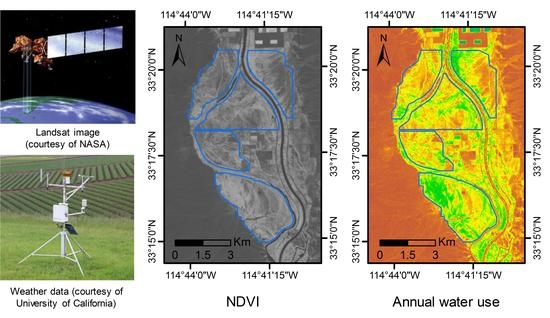Mapping Annual Riparian Water Use Based on the Single-Satellite-Scene Approach
Abstract
:1. Introduction
2. Materials and Methods
2.1. Study Area
2.2. Single-Satellite-Scene (SSS) Apporach
2.3. Long-Term Estimates
3. Results and Discussion
3.1. SSS Evaluation
3.2. Inter-Annual Variation of Water Use
3.3. Comparisons with MOD16 and LCRAS
3.4. Impact of Wildfire on Water Use
4. Conclusions
Acknowledgments
Author Contributions
Conflicts of Interest
References
- Owens, M.K.; Moore, G.W. Saltcedar water use: Realistic and unrealistic expectations. Rangel. Ecol. Manag. 2007, 60, 553–557. [Google Scholar] [CrossRef]
- Zavaleta, E. Valuing Ecosystem Services Lost to Tamarix Invasion in the United States; Island Press: Washington, DC, USA, 2000; pp. 261–300. [Google Scholar]
- Glenn, E.P.; Nagler, P.L. Comparative ecophysiology of Tamarix ramosissima and native trees in western U.S. riparian zones. J. Arid Environ. 2005, 61, 419–446. [Google Scholar] [CrossRef]
- Glenn, E.; Tanner, R.; Mendez, S.; Kehret, T.; Moore, D.; Garcia, J.; Valdes, C. Growth rates, salt tolerance and water use characteristics of native and invasive riparian plants from the delta of the Colorado River, Mexico. J. Arid Environ. 1998, 40, 281–294. [Google Scholar] [CrossRef]
- Vandersande, M.W.; Glenn, E.P.; Walworth, J.L. Tolerance of five riparian plants from the lower Colorado River to salinity drought and inundation. J. Arid Environ. 2001, 49, 147–159. [Google Scholar] [CrossRef]
- Cleverly, J.R.; Smith, S.D.; Sala, A.; Devitt, D.A. Invasive capacity of Tamarix ramosissima in a Mojave Desert floodplain: The role of drought. Oecologia 1997, 111, 12–18. [Google Scholar] [CrossRef] [PubMed]
- Stromberg, J.C. Functional equivalency of saltcedar (Tamarix chinensis) and fremont cottonwood (Populus fremonth) along a free-flowing river. Wetlands 1998, 18, 675–686. [Google Scholar] [CrossRef]
- Busch, D.E.; Smith, S.D. Effects of fire on water and salinity relations of riparian woody taxa. Oecologia 1993, 94, 186–194. [Google Scholar] [CrossRef] [PubMed]
- Bailey, J.K.; Schweitzer, J.A.; Whitham, T.G. Salt cedar negatively affects biodiversity of aquatic macroinvertebrates. Wetlands 2001, 21, 442–447. [Google Scholar] [CrossRef]
- Harms, R.S.; Hiebert, R.D. Vegetation response following invasive tamarisk (Tamarix spp.) removal and implications for riparian restoration. Restor. Ecol. 2006, 14, 461–472. [Google Scholar] [CrossRef]
- Di Tomaso, J.M. Impact, biology, and ecology of saltcedar (Tamarix spp.) in the southwestern United States. Weed Technol. 1998, 12, 326–336. [Google Scholar]
- Murray, R.S.; Nagler, P.L.; Morino, K.; Glenn, E.P. An empirical algorithm for estimating agricultural and riparian evapotranspiration using MODIS Enhanced Vegetation Index and ground measurements of ET. II. Application to the Lower Colorado River, U.S. Remote Sens. 2009, 1, 1125–1138. [Google Scholar] [CrossRef]
- Nagler, P.L.; Morino, K.; Didan, K.; Erker, J.; Osterberg, J.; Hultine, K.R.; Glenn, E.P. Wide-area estimates of saltcedar (Tamarix spp.) evapotranspiration on the lower Colorado River measured by heat balance and remote sensing methods. Ecohydrology 2009, 2, 18–33. [Google Scholar] [CrossRef]
- Taghvaeian, S.; Neale, C.M.; Osterberg, J.; Sritharan, S.I.; Watts, D.R. Water use and stream-aquifer-phreatophyte interaction along a Tamarisk-dominated segment of the Lower Colorado River. In Remote Sensing of the Terrestrial Water Cycle; John & Sons, Inc.: Hoboken, NJ, USA, 2014; pp. 95–113. [Google Scholar]
- Nagler, P.L.; Scott, R.L.; Westenburg, C.; Cleverly, J.R.; Glenn, E.P.; Huete, A.R. Evapotranspiration on western U.S. rivers estimated using the Enhanced Vegetation Index from MODIS and data from eddy covariance and Bowen ratio flux towers. Remote Sens. Environ. 2005, 97, 337–351. [Google Scholar] [CrossRef]
- Scott, R.L.; Cable, W.L.; Huxman, T.E.; Nagler, P.L.; Hernandez, M.; Goodrich, D.C. Multiyear riparian evapotranspiration and groundwater use for a semiarid watershed. J. Arid Environ. 2008, 72, 1232–1246. [Google Scholar] [CrossRef]
- Gowda, P.H.; Chavez, J.L.; Colaizzi, P.D.; Evett, S.R.; Howell, T.A.; Tolk, J.A. ET mapping for agricultural water management: Present status and challenges. Irrig. Sci. 2008, 26, 223–237. [Google Scholar] [CrossRef]
- Morton, C.G.; Huntington, J.L.; Pohll, G.M.; Allen, R.G.; McGwire, K.C.; Bassett, S.D. Assessing calibration uncertainty and automation for estimating evapotranspiration from agricultural areas using METRIC. JAWRA J. Am. Water Resour. Assoc. 2013, 49, 549–562. [Google Scholar] [CrossRef]
- Irmak, A.; Allen, R.G.; Kjaersgaard, J.; Huntington, J.; Kamble, B.; Trezza, R.; Ratcliffe, I. Operational remote sensing of ET and challenges. In Evapotranspiration-Remote Sensing and Modeling; InTech: Reijaka, Croatia, 2012; pp. 467–492. [Google Scholar]
- Kalma, J.D.; McVicar, T.R.; McCabe, M.F. Estimating land surface evaporation: A review of methods using remotely sensed surface temperature data. Surv. Geophys. 2008, 29, 421–469. [Google Scholar] [CrossRef]
- Glenn, E.P.; Huete, A.R.; Nagler, P.L.; Hirschboeck, K.K.; Brown, P. Integrating remote sensing and ground methods to estimate evapotranspiration. Crit. Rev. Plant Sci. 2007, 26, 139–168. [Google Scholar] [CrossRef]
- Gonzalez-Dugo, M.P.; Neale, C.M.U.; Mateos, L.; Kustas, W.P.; Prueger, J.H.; Anderson, M.C.; Li, F. A comparison of operational remote sensing-based models for estimating crop evapotranspiration. Agric. For. Meteorol. 2009, 149, 1843–1853. [Google Scholar] [CrossRef]
- Bawazir, A.S.; Samani, Z.; Bleiweiss, M.; Skaggs, R.; Schmugge, T. Using ASTER satellite data to calculate riparian evapotranspiration in the Middle Rio Grande, New Mexico. Int. J. Remote Sens. 2009, 30, 5593–5603. [Google Scholar] [CrossRef]
- Kamble, B.; Irmak, A.; Martin, D.L.; Hubbard, K.G.; Ratcliffe, I.; Hergert, G.; Narumalani, S.; Oglesby, R.J. Satellite based energy balance approach to assess riparian water use. In Evapotranspiration—An Overview; InTech: Reijaka, Croatia, 2013; pp. 79–95. [Google Scholar]
- Liebert, R.; Huntington, J.; Morton, C.; Sueki, S.; Acharya, K. Reduced evapotranspiration from leaf beetle induced tamarisk defoliation in the Lower Virgin River using satellite-based energy balance. Ecohydrology 2016, 9, 179–193. [Google Scholar] [CrossRef]
- Qi, J.; Chehbouni, A.; Huete, A.R.; Kerr, Y.H.; Sorooshian, S. A modified soil adjusted vegetation index. Remote Sens. Environ. 1994, 48, 119–126. [Google Scholar] [CrossRef]
- Nichols, W.D. Regional Ground-Water Evapotranspiration and Ground-Water Budgets, Great Basin, Nevada; United States Geological Survey Professional Paper 1628; U.S. Geological Survey: Great Basin, NV, USA, 2000.
- Huete, A.; Didan, K.; Miura, T.; Rodriguez, E.P.; Gao, X.; Ferreira, L.G. Overview of the radiometric and biophysical performance of the MODIS vegetation indices. Remote Sens. Environ. 2002, 83, 195–213. [Google Scholar] [CrossRef]
- Nagler, P.L.; Glenn, E.P.; Nguyen, U.; Scott, R.L.; Doody, T. Estimating riparian and agricultural actual evapotranspiration by reference evapotranspiration and MODIS enhanced vegetation index. Remote Sens. 2013, 5, 3849–3871. [Google Scholar] [CrossRef]
- Tillman, F.D.; Callegary, J.B.; Nagler, P.L.; Glenn, E.P. A simple method for estimating basin-scale groundwater discharge by vegetation in the basin and range province of Arizona using remote sensing information and geographic information systems. J. Arid Environ. 2012, 82, 44–52. [Google Scholar] [CrossRef]
- Nagler, P.L.; Cleverly, J.; Glenn, E.; Lampkin, D.; Huete, A.; Wan, Z. Predicting riparian evapotranspiration from MODIS vegetation indices and meteorological data. Remote Sens. Environ. 2005, 94, 17–30. [Google Scholar] [CrossRef]
- Nagler, P.L.; Morino, K.; Murray, R.S.; Osterberg, J.; Glenn, E.P. An empirical algorithm for estimating agricultural and riparian evapotranspiration using MODIS enhanced vegetation index and ground measurements of ET. I. Description of method. Remote Sens. 2009, 1, 1273–1297. [Google Scholar] [CrossRef]
- Brouwer, C.; Heibloem, M. Irrigation Water Management Training Manual No. 3; FAO: Rome, Italy, 1986. [Google Scholar]
- Allen, R.G.; Clemmens, A.J.; Burt, C.M.; Solomon, K.; O’Halloran, T. Prediction accuracy for projectwide evapotranspiration using crop coefficients and reference evapotranspiration. J. Irrig. Drain. Eng. 2005, 131, 24–36. [Google Scholar] [CrossRef]
- Groeneveld, D.P.; Baugh, W.M.; Sanderson, J.S.; Cooper, D.J. Annual groundwater evapotranspiration mapped from single satellite scenes. J. Hydrol. 2007, 344, 146–156. [Google Scholar] [CrossRef]
- Groeneveld, D.P.; Baugh, W.M. Correcting satellite data to detect vegetation signal for eco-hydrologic analyses. J. Hydrol. 2007, 344, 135–145. [Google Scholar] [CrossRef]
- Beamer, J.P.; Huntington, J.L.; Morton, C.G.; Pohll, G.M. Estimating annual groundwater evapotranspiration from phreatophytes in the great basin using landsat and flux tower measurements. JAWRA J. Am. Water Resour. Assoc. 2013, 49, 518–533. [Google Scholar] [CrossRef]
- Groeneveld, D.P. Remotely-sensed groundwater evapotranspiration from alkali scrub affected by declining water table. J. Hydrol. 2008, 358, 294–303. [Google Scholar] [CrossRef]
- Glenn, E.P.; Jarchow, C.J.; Waugh, W.J. Evapotranspiration dynamics and effects on groundwater recharge and discharge at an arid waste disposal site. J. Arid Environ. 2016, 133, 1–9. [Google Scholar] [CrossRef]
- Barz, D.; Watson, R.P.; Kanney, J.F.; Roberts, J.D.; Groeneveld, D.P. Cost/benefit considerations for recent saltcedar control, Middle Pecos River, New Mexico. Environ. Manag. 2009, 43, 282. [Google Scholar] [CrossRef] [PubMed]
- Mexicano, L.; Glenn, E.P.; Hinojosa-Huerta, O.; Garcia-Hernandez, J.; Flessa, K.; Hinojosa-Corona, A. Long-term sustainability of the hydrology and vegetation of Cienega de Santa Clara, an anthropogenic wetland created by disposal of agricultural drain water in the delta of the Colorado River, Mexico. Ecol. Eng. 2013, 59, 111–120. [Google Scholar] [CrossRef]
- Nagler, P.L.; Brown, T.; Hultine, K.R.; van Riper, C.; Bean, D.W.; Dennison, P.E.; Murray, R.S.; Glenn, E.P. Regional scale impacts of Tamarix leaf beetles (Diorhabda carinulata) on the water availability of western U.S. rivers as determined by multi-scale remote sensing methods. Remote Sens. Environ. 2012, 118, 227–240. [Google Scholar] [CrossRef]
- Jarchow, C.J.; Nagler, P.L.; Glenn, E.P. Greenup and evapotranspiration following the Minute 319 pulse flow to Mexico: An analysis using Landsat 8 Normalized Difference Vegetation Index (NDVI) data. Ecol. Eng. in press. [CrossRef]
- Huete, A.R.; Liu, H.Q. An error and sensitivity analysis of the atmospheric-and soil-correcting variants of the NDVI for the MODIS-EOS. IEEE Trans. Geosci. Remote Sens. 1994, 32, 897–905. [Google Scholar] [CrossRef]
- Liu, H.Q.; Huete, A. A feedback based modification of the NDVI to minimize canopy background and atmospheric noise. IEEE Trans. Geosci. Remote Sens. 1995, 33, 457–465. [Google Scholar]
- Masek, J.G.; Vermote, E.F.; Saleous, N.; Wolfe, R.; Hall, F.G.; Huemmrich, F.; Gao, F.; Kutler, J.; Lim, T.K. LEDAPS Landsat Calibration, Reflectance, Atmospheric Correction Preprocessing Code; Model Product; Oak Ridge National Laboratory Distributed Active Archive Center: Oak Ridge, TN, USA, 2012. [CrossRef]
- Bastiaanssen, W.G.M.; Menenti, M.; Feddes, R.A.; Holtslag, A.A.M. A remote sensing surface energy balance algorithm for land (SEBAL). 1. Formulation. J. Hydrol. 1998, 212, 198–212. [Google Scholar] [CrossRef]
- Bastiaanssen, W.G.M.; Noordman, E.J.M.; Pelgrum, H.; Davids, G.; Thoreson, B.P.; Allen, R.G. SEBAL model with remotely sensed data to improve water-resources management under actual field conditions. J. Irrig. Drain. Eng. 2005, 131, 85–93. [Google Scholar] [CrossRef]
- Allen, R.G.; Tasumi, M.; Trezza, R. Satellite-based energy balance for mapping evapotranspiration with internalized calibration (METRIC)-Model. J. Irrig. Drain. Eng. 2007, 133, 380–394. [Google Scholar] [CrossRef]
- White, W.N. A Method of Estimating Ground-Water Supplies Based on Discharge by Plants and Evaporation from Soil: Results of Investigations in Escalante Valley, Utah; U.S. Government Printing Office: Washington, DC, USA, 1932; pp. 1–106.
- Environmental and Water Resources Institute of the American Society of Civil Engineers (ASCE-EWRI). The ASCE Standardized Reference Evapotranspiration Equation; Report of the ASCE-EWRI Task Committee on Standardization of Reference Evapotranspiration; ASCE: Reston, VA, USA, 2005. [Google Scholar]
- Mu, Q.; Heinsch, F.A.; Zhao, M.; Running, S.W. Development of a global evapotranspiration algorithm based on MODIS and global meteorology data. Remote Sens. Environ. 2007, 111, 519–536. [Google Scholar] [CrossRef]
- Mu, Q.; Zhao, M.; Running, S.W. Improvements to a MODIS global terrestrial evapotranspiration algorithm. Remote Sens. Environ. 2011, 115, 1781–1800. [Google Scholar] [CrossRef]
- Monteith, J. Evaporation and environment. Symp. Soc. Exp. Biol. 1965, 19, 205–234. [Google Scholar] [PubMed]
- United States Bureau of Reclamation. Lower Colorado River Accounting System. Evapotranspiration and Evaporation Calculations, Calendar Year 2005; United States Bureau of Reclamation: Boulder, NV, USA, 2007.
- United States Bureau of Reclamation. Lower Colorado River Accounting System. Evapotranspiration and Evaporation Calculations, Calendar Year 2010; United States Bureau of Reclamation: Boulder, NV, USA, 2014.
- Allen, R.G.; Pereira, L.S.; Howell, T.A.; Jensen, M.E. Evapotranspiration information reporting: I. Factors governing measurement accuracy. Agric. Water Manag. 2011, 98, 899–920. [Google Scholar] [CrossRef]
- Smith, J.L.; Laczniak, R.J.; Moreo, M.T.; Welborn, T.L. Mapping Evapotranspiration Units in the Basin and Range Carbonate-Rock Aquifer System, White Pine County, Nevada, and Adjacent Areas in Nevada and Utah; United States Geological Survey Scientific Investigations Report 2007-5087; U.S. Geological Survey: Reston, VA, USA, 2007.
- Allander, K.K.; Smith, J.L.; Johnson, M.J. Evapotranspiration from the Lower Walker River Basin, West-Central Nevada, Water Years 2005–07; United States Geological Survey Scientific Investigations Report 2009-5079; U.S. Geological Survey: Reston, VA, USA, 2009.
- Nagler, P.L.; Pearlstein, S.; Glenn, E.P.; Brown, T.B.; Bateman, H.L.; Bean, D.W.; Hultine, K.R. Rapid dispersal of saltcedar (Tamarix spp.) biocontrol beetles (Diorhabda carinulata) on a desert river detected by phenocams, MODIS imagery and ground observations. Remote Sens. Environ. 2014, 140, 206–219. [Google Scholar]
- Los Angeles Department of Water and Power (LADWP). Urban Water Management Plan; Arcadis U.S., Inc.: Los Angeles, CA, USA, 2015. [Google Scholar]
- Nagler, P.L.; Glenn, E.P.; Didan, K.; Osterberg, J.; Jordan, F.; Cunningham, J. Wide-Area Estimates of Stand Structure and Water Use of Tamarix spp. on the Lower Colorado River: Implications for Restoration and Water Management Projects. Restor. Ecol. 2008, 16, 136–145. [Google Scholar] [CrossRef]
- Friedl, M.A.; McIver, D.K.; Hodges, J.C.; Zhang, X.Y.; Muchoney, D.; Strahler, A.H.; Woodcock, C.E.; Gopal, S.; Schneider, A.; Baccini, A.; et al. Global land cover mapping from MODIS: Algorithms and early results. Remote Sens. Environ. 2002, 83, 287–302. [Google Scholar] [CrossRef]
- Friedl, M.A.; Sulla-Menashe, D.; Tan, B.; Schneider, A.; Ramankutty, N.; Sibley, A.; Huang, X. MODIS Collection 5 global land cover: Algorithm refinements and characterization of new datasets. Remote Sens. Environ. 2010, 114, 168–182. [Google Scholar] [CrossRef]
- Velpuri, N.M.; Senay, G.B.; Singh, R.K.; Bohms, S.; Verdin, J.P. A comprehensive evaluation of two MODIS evapotranspiration products over the conterminous United States: Using point and gridded FLUXNET and water balance ET. Remote Sens. Environ. 2013, 139, 35–49. [Google Scholar] [CrossRef]
- Ruhoff, A.L.; Paz, A.R.; Aragao, L.E.O.C.; Mu, Q.; Malhi, Y.; Collischonn, W.; Rocha, H.R.; Running, S.W. Assessment of the MODIS global evapotranspiration algorithm using eddy covariance measurements and hydrological modelling in the Rio Grande basin. Hydrol. Sci. J. 2013, 58, 1658–1676. [Google Scholar] [CrossRef]
- Biggs, T.W.; Marshall, M.; Messina, A. Mapping daily and seasonal evapotranspiration from irrigated crops using global climate grids and satellite imagery: Automation and methods comparison. Water Resour. Res. 2016, 52, 7311–7326. [Google Scholar] [CrossRef]
- Jensen, M.E. Vegetative and Open Water Coefficients for the Lower Colorado River Accounting System (Addendum to the 1998 Report); United States Bureau of Reclamation; Boulder Canyon Operations Office: Boulder City, NV, USA, 2003.
- Westenberg, C.; Harper, D.; DeMeo, G. Evapotranspiration by Phreatophytes Along the Lower Colorado River at Havasu National Wildlife Refuge, Arizona; United States Geological Survey Scientific Investigations Report, 2006-5043; U.S. Geological Survey: Henderson, NV, USA, 2006.
- Lewis, C.S. Evapotranspiration Estimation: A Study of Methods in the Western United States. Ph.D. Thesis, Civil Engineering-Utah State University, Logan, UT, USA, 2016. [Google Scholar]
- Devitt, D.A.; Sala, A.; Smith, S.D.; Cleverly, J.; Shaulis, L.K.; Hammett, R. Bowen ratio estimates of evapotranspiration for Tamarix ramosissima stands on the Virgin River in southern Nevada. Water Resour. Res. 1998, 34, 2407–2414. [Google Scholar] [CrossRef]
- Stromberg, J.C.; Rychener, T.J. Effects of fire on riparian forests along a free-flowing dryland river. Wetlands 2010, 30, 75–86. [Google Scholar] [CrossRef]

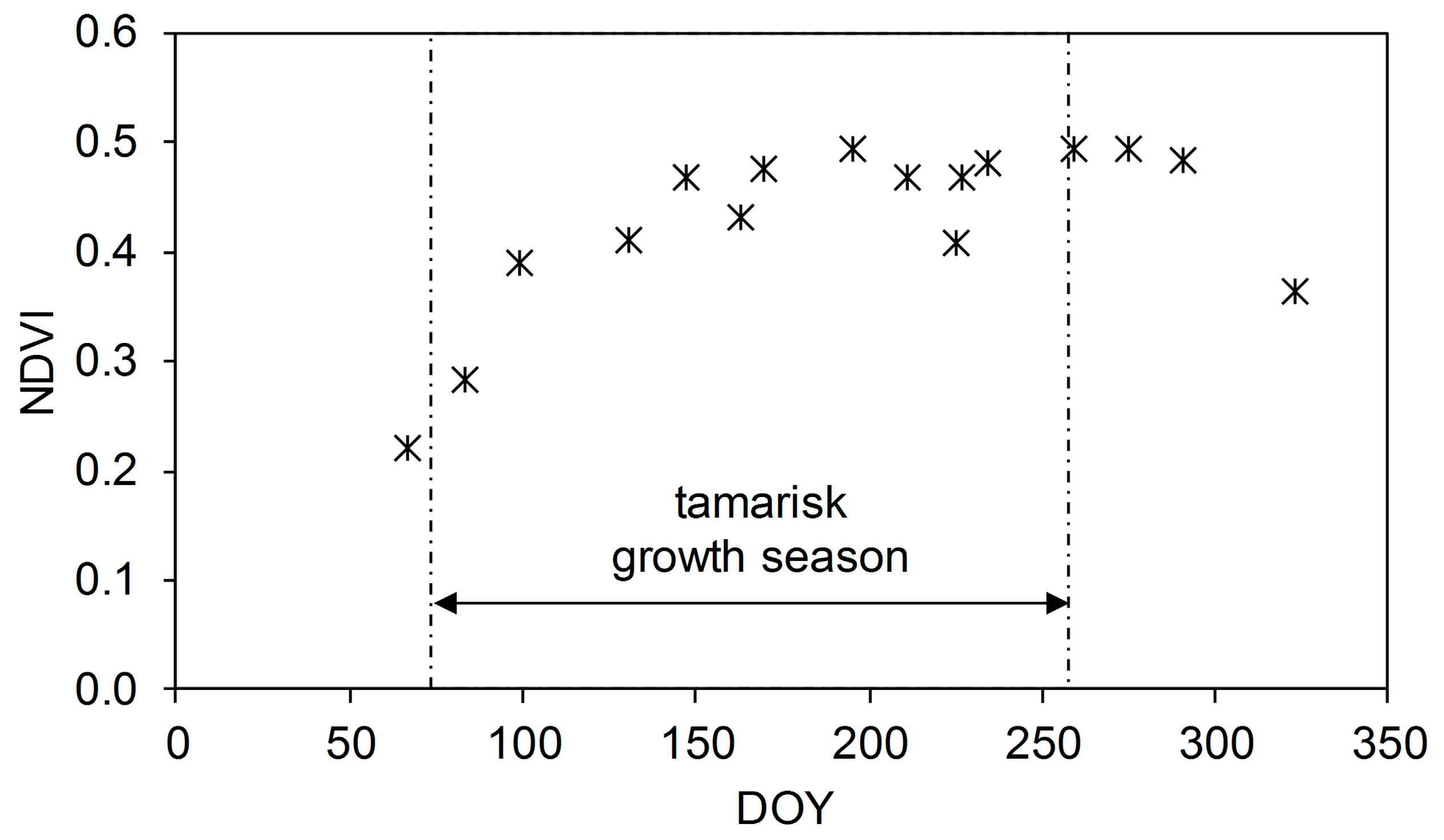

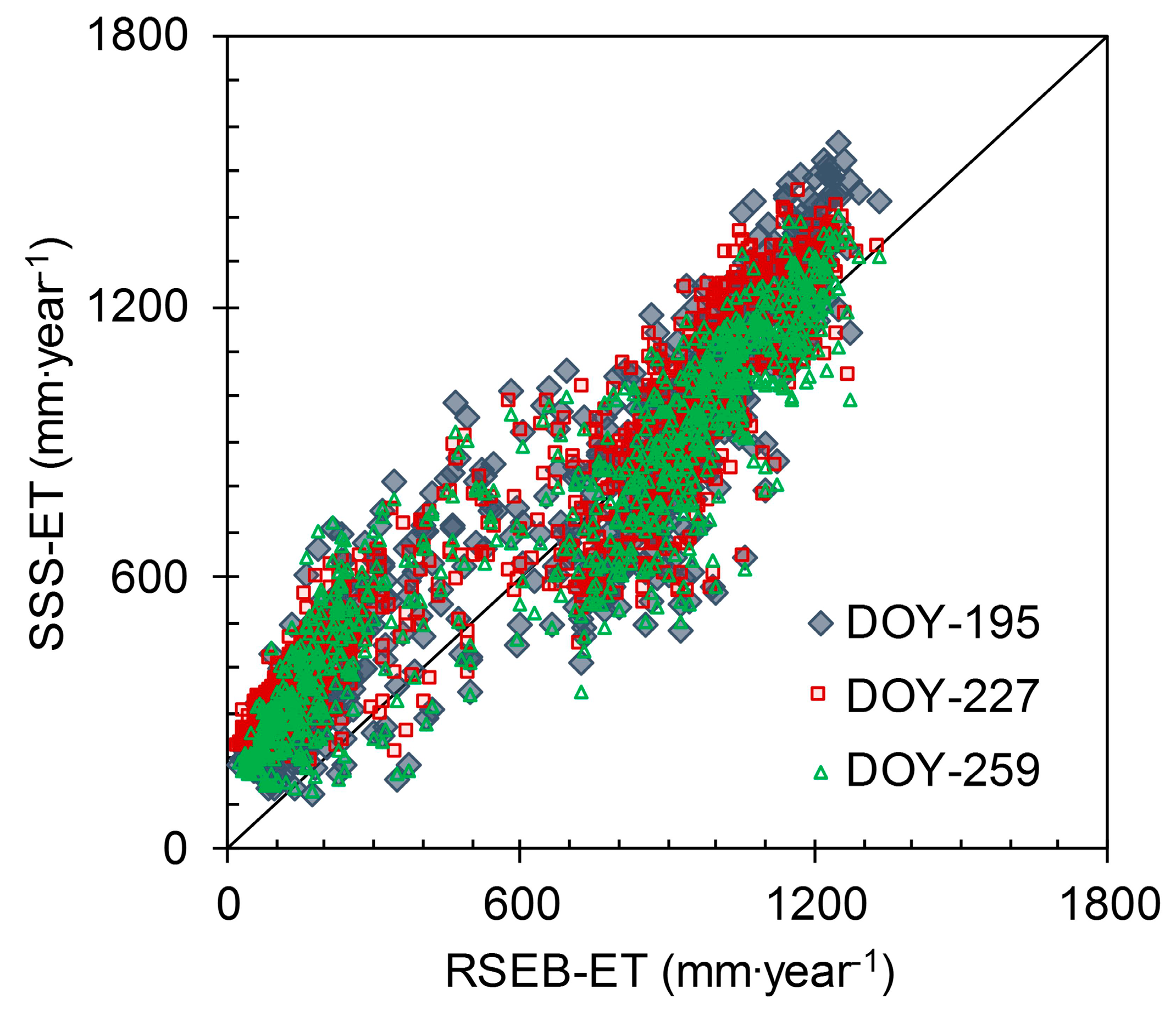

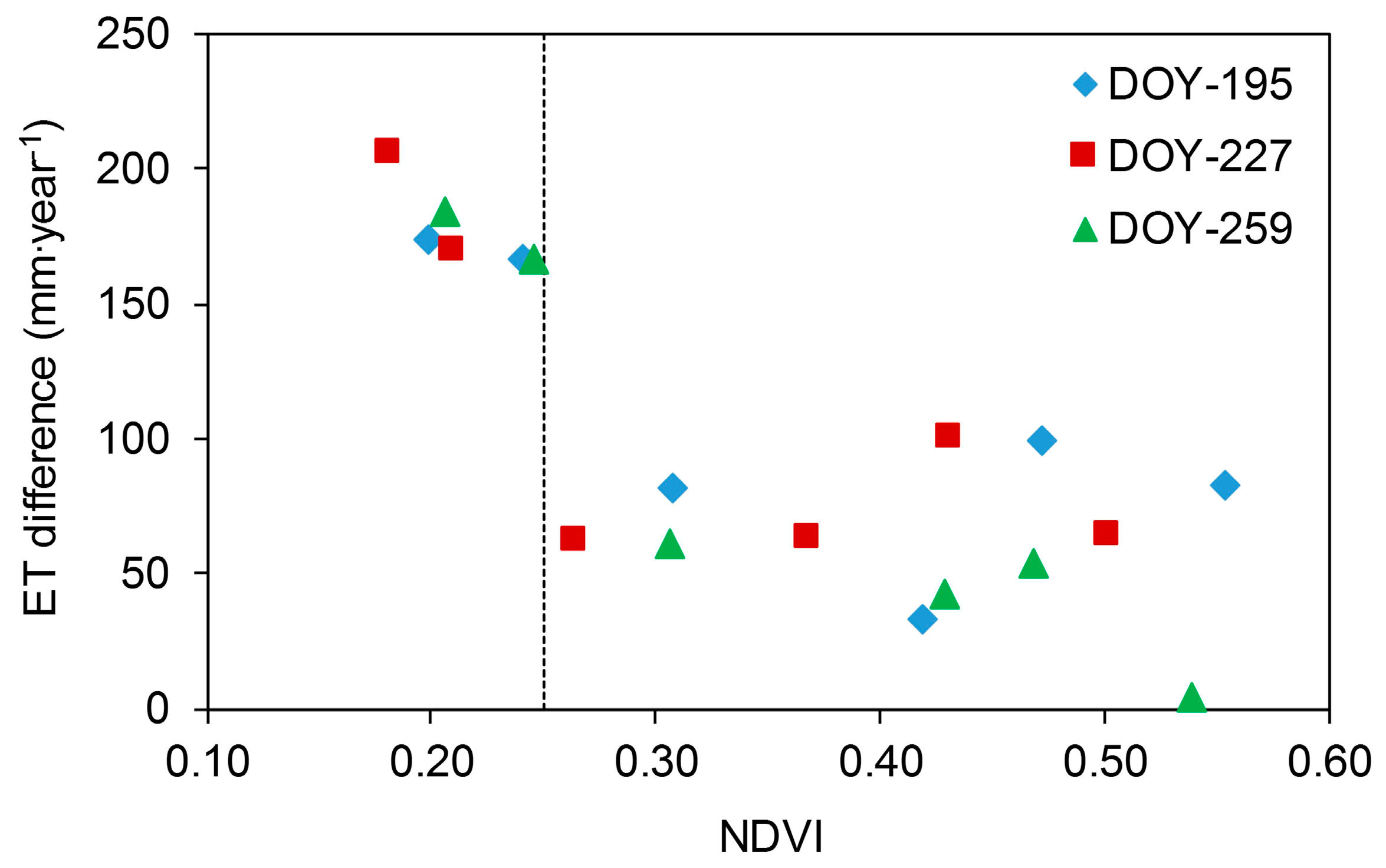

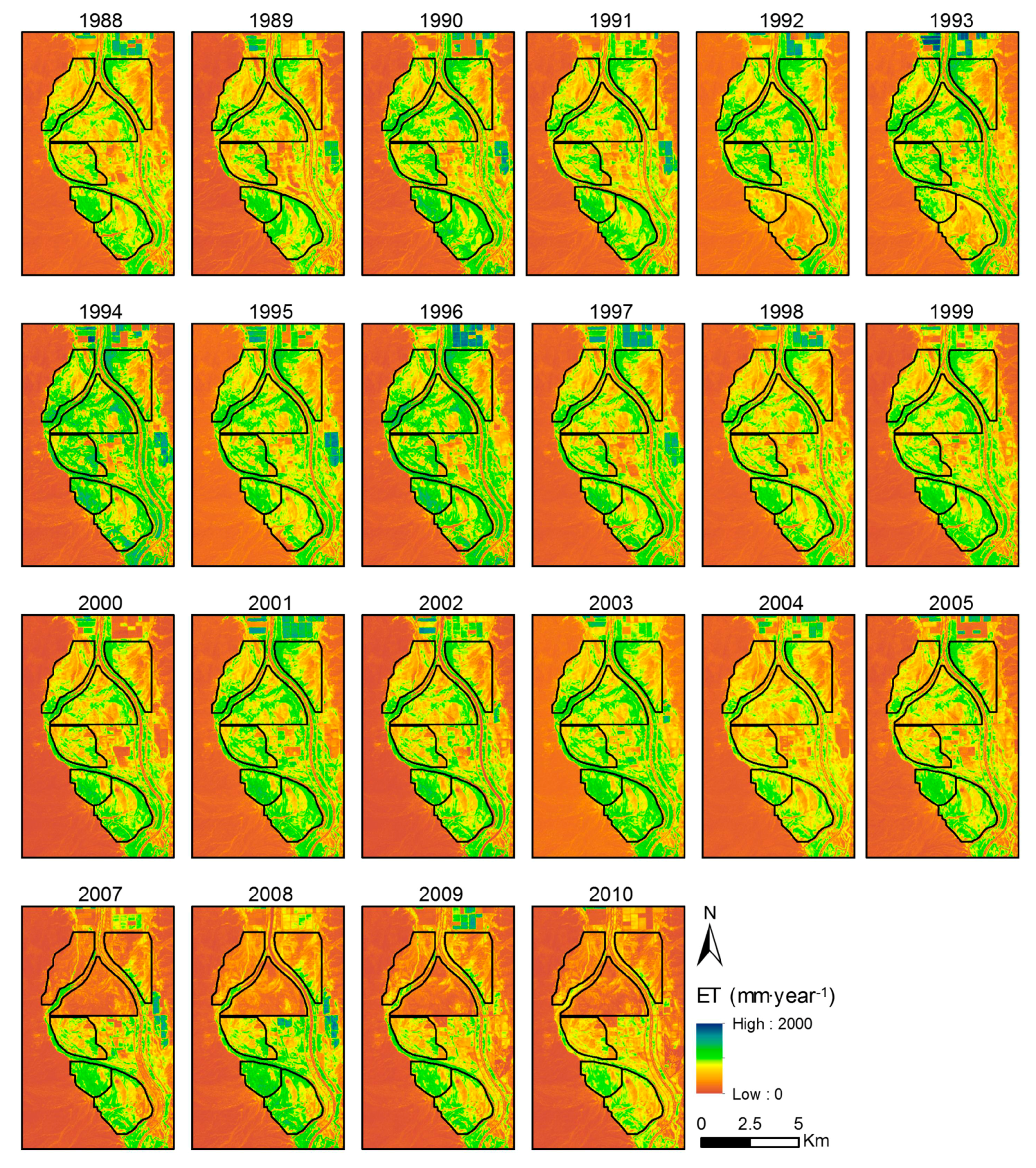

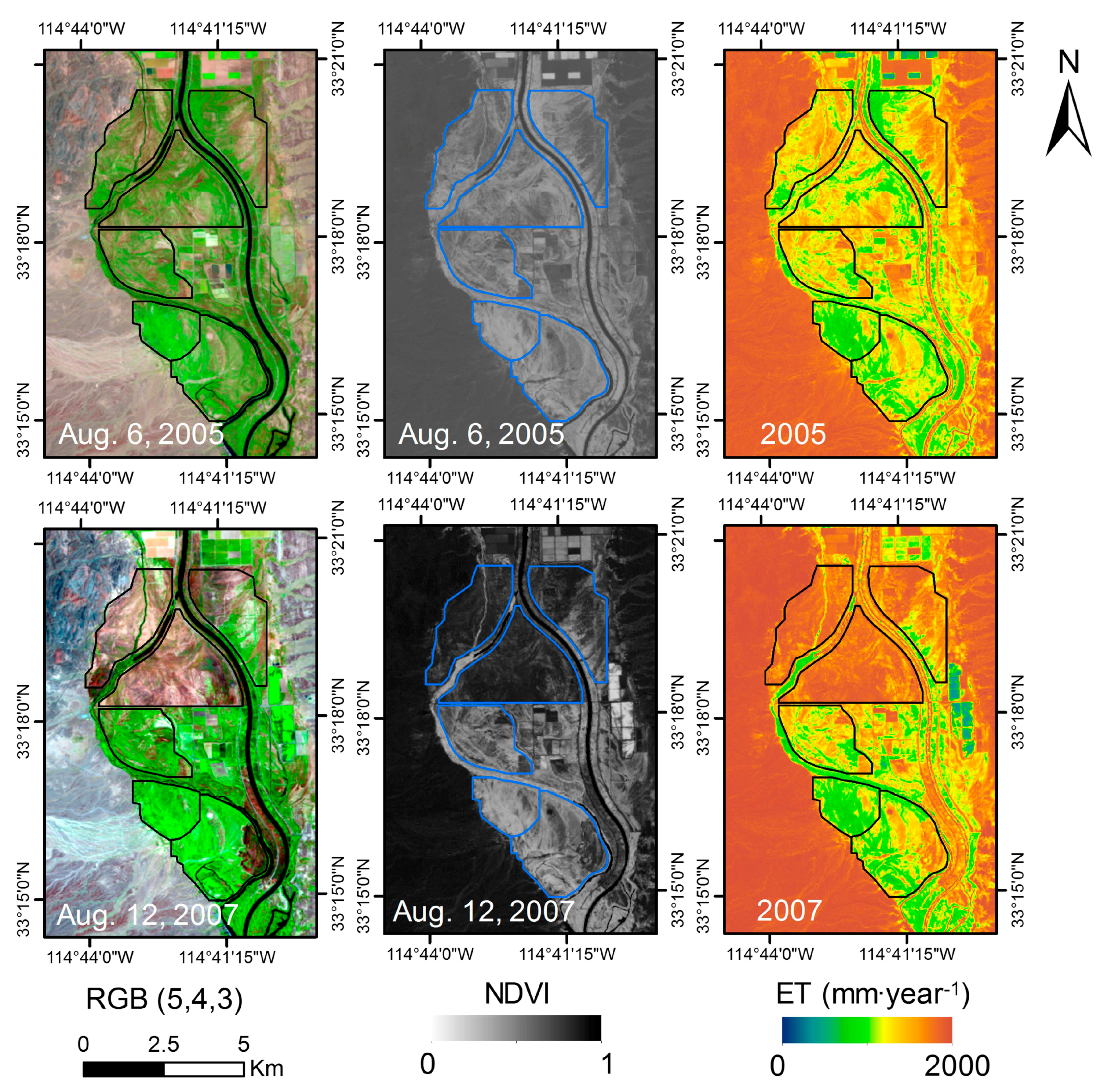
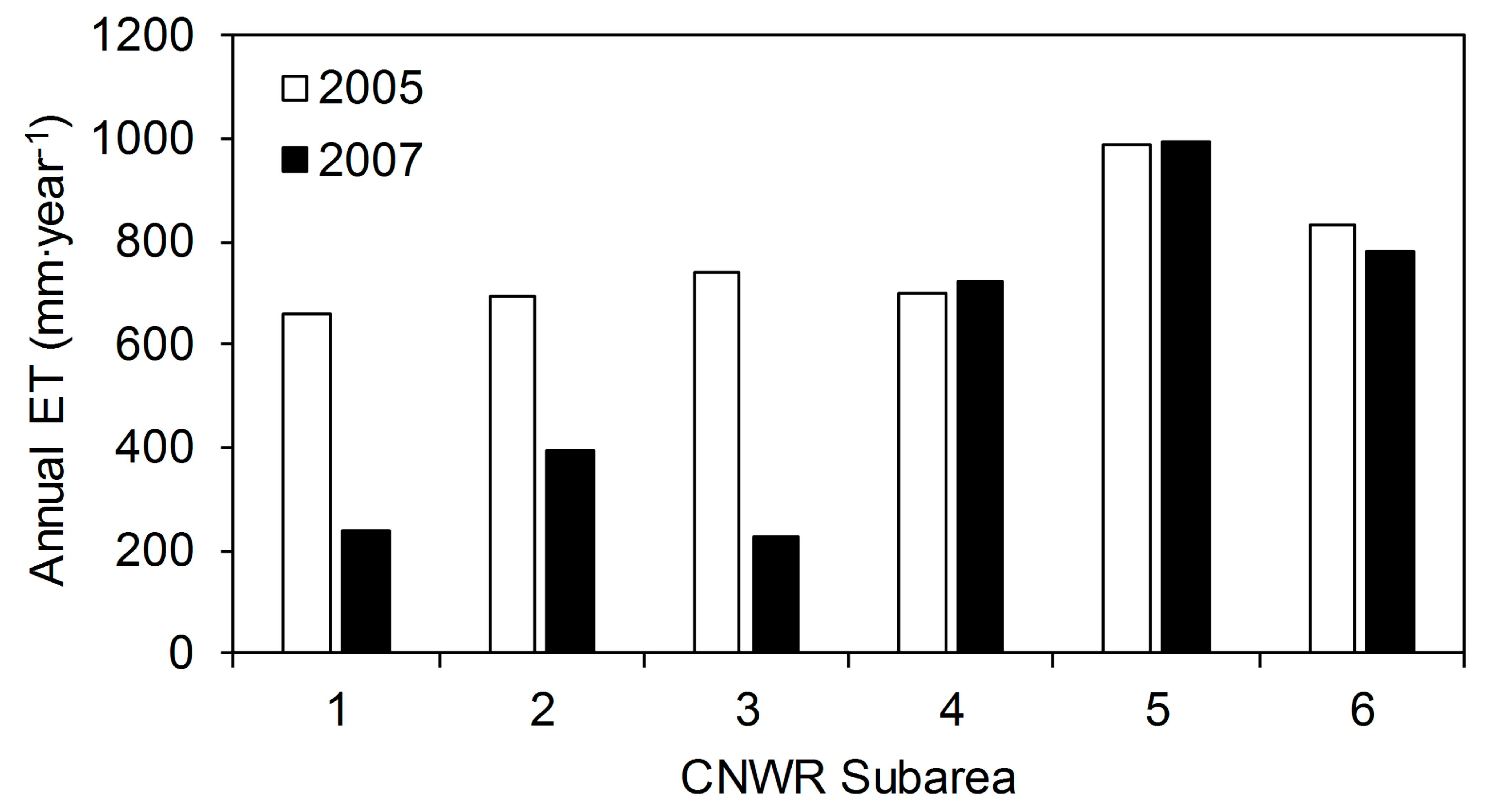
| Scale | DOY | SSS-ET (mm∙year−1) | RSEB-ET (mm∙year−1) | R2 | Residual Error (mm∙year−1) | Percent Error |
|---|---|---|---|---|---|---|
| Pixel-based | 195 | 693 | 589 | 0.86 | 104 | 17.7 |
| 227 | 692 | 589 | 0.87 | 103 | 17.5 | |
| 259 | 673 | 589 | 0.86 | 84 | 14.3 | |
| Area-wide | 195 | 732 | 637 | 0.97 | 95 | 14.9 |
| 227 | 727 | 637 | 0.96 | 90 | 14.1 | |
| 259 | 708 | 637 | 0.98 | 71 | 11.1 |
| Year | DOY | NDVIo | NDVIs | ETo (mm∙year−1) | Precipitation (mm∙year−1) | SSS-ET (mm∙year−1) |
|---|---|---|---|---|---|---|
| 1988 | 220 | 0.08 | 1.00 | 1836 | 129 | 762 |
| 1989 | 238 | 0.07 | 0.92 | 1752 | 39 | 762 |
| 1990 | 241 | 0.06 | 0.94 | 1855 | 53 | 854 |
| 1991 | 244 | 0.07 | 0.88 | 1746 | 78 | 793 |
| 1992 | 215 | 0.08 | 0.83 | 1790 | 161 | 769 |
| 1993 | 217 | 0.09 | 1.00 | 1960 | 126 | 783 |
| 1994 | 236 | 0.08 | 0.89 | 2015 | 40 | 915 |
| 1995 | 223 | 0.09 | 0.88 | 1866 | 144 | 826 |
| 1996 | 226 | 0.08 | 0.95 | 1868 | 53 | 898 |
| 1997 | 212 | 0.08 | 0.93 | 1732 | 80 | 787 |
| 1998 | 215 | 0.09 | 0.96 | 1738 | 89 | 762 |
| 1999 | 218 | 0.08 | 1.00 | 1793 | 55 | 816 |
| 2000 | 221 | 0.07 | 0.87 | 1748 | 6 | 750 |
| 2001 | 223 | 0.07 | 0.87 | 1754 | 80 | 851 |
| 2002 | 226 | 0.08 | 0.87 | 1805 | 1 | 746 |
| 2003 | 229 | 0.07 | 0.92 | 1709 | 177 | 849 |
| 2004 | 248 | 0.08 | 1.00 | 1696 | 80 | 677 |
| 2005 | 218 | 0.10 | 0.90 | 1668 | 72 | 754 |
| 2006 | 237 | 0.07 | 0.91 | 1768 | 10 | NA |
| 2007 | 224 | 0.08 | 0.91 | 1774 | 10 | 508 |
| 2008 | 227 | 0.05 | 0.84 | 1815 | 1 | 598 |
| 2009 | 229 | 0.09 | 0.88 | 1728 | 19 | 524 |
| 2010 | 232 | 0.10 | 0.91 | 1644 | 19 | 483 |
© 2017 by the authors. Licensee MDPI, Basel, Switzerland. This article is an open access article distributed under the terms and conditions of the Creative Commons Attribution (CC BY) license (http://creativecommons.org/licenses/by/4.0/).
Share and Cite
Khand, K.; Taghvaeian, S.; Hassan-Esfahani, L. Mapping Annual Riparian Water Use Based on the Single-Satellite-Scene Approach. Remote Sens. 2017, 9, 832. https://doi.org/10.3390/rs9080832
Khand K, Taghvaeian S, Hassan-Esfahani L. Mapping Annual Riparian Water Use Based on the Single-Satellite-Scene Approach. Remote Sensing. 2017; 9(8):832. https://doi.org/10.3390/rs9080832
Chicago/Turabian StyleKhand, Kul, Saleh Taghvaeian, and Leila Hassan-Esfahani. 2017. "Mapping Annual Riparian Water Use Based on the Single-Satellite-Scene Approach" Remote Sensing 9, no. 8: 832. https://doi.org/10.3390/rs9080832





